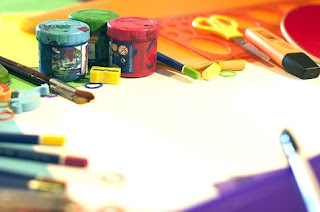I'll be reviewing Christopher's book shortly, but I wanted to share this great post from him, about just HOW important ART should be in you child's daily curriculum.
Being a homeschool mom, I know how art can tie in all the concepts a child is learning, giving them a hands on way of expressing them visually. Art also helps kids RETAIN what they have learned.So, I was interested to what Christopher would say, and you will be too!
 |
| Courtesy of Pixabay |
We’ve all heard a lot lately about STEM (Science, Technology, Engineering, Math) in school, but we shouldn’t overlook the benefits students get from a good art education. It’s not just about drawing pictures or playing an instrument. The things a student get from arts education can easily transfer to other parts of their learning.
Art requires planning. Before the artist puts the brush to the canvas, they need to think about where things go and what they look like. The artist must visualize the final outcome before they even begin. This planning and thinking ahead will assist the student in other aspects of their learning, and later in life as well. Before the student sites an essay, they’ll think it through first. This planning will help them think about all kinds of things before they begin, which is absolutely a good skill to have.
 |
| Courtesy of Pixabay |
Performing and visual arts require a certain level of pride and craftsmanship that the student may not get from their other classes. At the very least, they will play off of each other, where the student who takes art classes may find their math work to be more precise, or their science work to be easier to read. They’ll probably keep their notebooks more organized, too.
Art students will be more astute observers, will pay closer attention to detail, and will be better equipped to recognize relationships between objects, proportions, and patterns. This will carry over to math and science. The art student’s sensitivity to detail may help them analyze literature better, to understand a literary character’s motivations, or to recognize more clearly the cause and effect of historical events. They’ll also beat you at chess.
 |
| Courtesy of Pixabay |
Students who develop a strong background in arts are more imaginative, more open, and more likely to invent and innovate. Creative people create. They solve problems. They don’t just complain about something, they fix it. And many times, they approach the problem from a direction that others wouldn’t have thought of.
Lastly, the creative and artistic student will be more expressive. They’ll be more in touch with their thoughts, feelings, emotions, and mental state. Their art will help them release pressure that might otherwise build up inside them. This regular release of stress will help them cope with difficult situations, and the frequent self-expression will help them build confidence and relate to others.
 |
| Courtesy of Pixabay |
Education in the arts is more than just drawing pictures or reading music. It’s fostering new skills in young people that directly impact their ability to do so many other things. Art is a necessary part of educating any well-rounded student, and helping them maximize their potential.
About the Author:
Christopher Locke is an illustrator, sculptor, and teacher based in Austin, Texas, and author of Draw Like This! How Anyone Can See the World Like an Artist—and Capture It on Paper (TarcherPerigee/Penguin, 10/4/16). His work has been featured in a number of publications including, Details, Reason, The Week,PC World, and Travel and Leisure, and can be found on his website, heartlessmachine.com.

Comments
Post a Comment